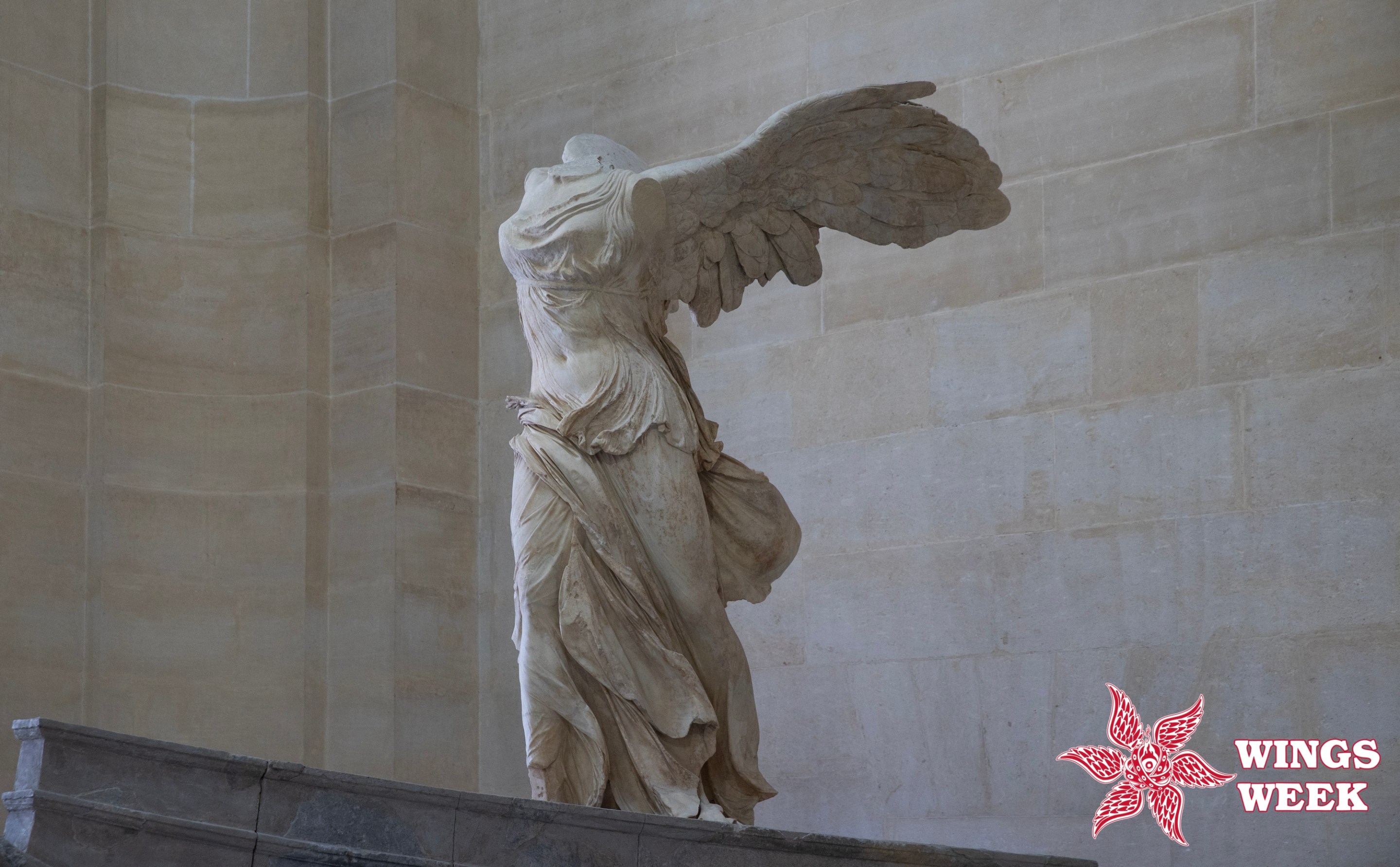There is a party game I like to play with friends. The question itself is basic: Is there a piece of art you would sacrifice yourself to save? But like any good ice-breaker, it works because it contains several more questions within it. How much is your life worth to you? Do you value the sustaining power of art? Is the communal more important than the individual? Whose work deserves to last more than you do? It’s a question about history, about legacy, about what we choose to protect. It’s a question to which many reasonable people answer “none.” There is no art for which they would sacrifice their life. I have to assume that none of these people have ever seen the Winged Victory of Samothrace.
The Winged Victory of Samothrace sits at the top of the Daru staircase inside the Louvre. She has been there since 1883, because there is no place more perfect for her. You must rise to meet her. She looms over the entry hall, beckoning you upward. I’ve spoken to people who, upon returning from a visit to the Louvre, note that they missed the Venus de Milo entirely. I have to assume this is because to get to the Venus de Milo, you would have to see the Winged Victory, ignore her, and proceed to move down the hall instead of up the staircase towards her, which is almost impossible. She is so mesmerizing.
The Winged Victory is made of marble. Anyone who has ever created any work in three dimensions dreams of marble. It is so shiny, so beautiful, and so difficult. Not only is marble very heavy—almost impossible to transport, much less turn—it has very low tensile strength, which means that it fractures easily. To work in marble is to face failure. Carve it too thin and it will fracture. Try to work too closely with it, and a chunk will fall off. Worry about every step because at any moment, you could be betrayed by the stone in front of you. Most beloved works in marble are giant for this reason. To create detail out of a stone that does not want you to have it, you need even the smallest details to be large enough in scale that when you force them out with a chisel, they won’t shatter. The Winged Victory is eight feet tall.
Michelangelo famously said of his sculptures that they are “already complete within the marble block, before I start my work. It is already there, I just have to chisel away the superfluous material.” In the case of his David, that material was a 17-foot-tall slab of marble.
The Belvedere Torso, an early marble sculpture of a torso missing its legs, arms, and head, was dredged up from the sea in mediocre condition. This happened during Michelangelo’s lifetime, and he became so obsessed with it people nicknamed the torso “the school of Michelangelo.” It’s easy to see why he found it so inspiring, why it spurred him to new heights of artistry: Even in its decimation, you can see its beauty, the agony of the twisted torso, the ecstasy of a perfectly built collarbone.
I wish that we had discovered the Winged Victory earlier. Though it is believed to have been completed in the beginning of the 2nd century B.C.E., it was not found until 1863, on the Greek Island of Samothrace. It was found in pieces: 15 large gray marble blocks: a bust, and some fragments of drapery. The base was found later. And though the pieces could not stand on their own, the curators at the Louvre made them stand. They connected the wing with wire, and built a second wing out of plaster to match it. They stitched her back together again. In 1950, her hand was found, and reunited with her body.
The first time I saw the Winged Victory I was in high school. Weirdly, I had won at a Dallas Stars game roundtrip tickets to anywhere American Airlines flew, and so my mother and I went to Paris for the few days we could afford to be there. I knew it was a stretch for us, but the tickets were free, and the two of us love museums and art. We went to the Louvre early in the trip, and a part of me never left.
I have long since forgotten most of the trip, but I remember walking toward Winged Victory, my hand over my mouth. Every time I have seen her since, I have cried. She is so monumental, the folds of her fabric so soft out of such a hard material. She appears to be in motion, as if the wind is hitting her all at once. The sculpted fabric is so thin that you can see the indent of her belly button through the dress that billows out from her hips. The wings extend behind her, uneven, perfect. She has no head, no arms. She does not need them. Her legs emerge from the rolls of fabric, powerful, as if they are in action. She appears to have just landed, the impact still apparent in her posture. The first time I saw her, one leg was still supported by a metal vice that has since been removed. She is continually being restored to a more complete version of herself.
The Futurist art movement was wrong about so many things. They were fascists and sexists and racists. In their manifesto, they wrote, “We declare that the splendor of the world has been enriched by a new beauty: the beauty of speed. A racing automobile with its bonnet adorned with great tubes like serpents with explosive breath ... a roaring motor car which seems to run on machine-gun fire, is more beautiful than the Victory of Samothrace.” This is an embarrassing and bad take.
But it’s interesting that they chose a sculpture with so much implied motion. There is so much energy in such a solid piece of rock. There is almost nothing more beautiful than her.
During the Second World War, the Winged Victory, along with many other treasured pieces of art, was removed from the Louvre. She was the last piece to leave. She was packed into a giant wooden crate and taken to hide at a Chateau that got lucky and was never occupied by Nazis. She couldn’t have been moved from place to place like the Mona Lisa. She was too big. But she was saved. Someone, a group of people, saved her, because they understood she is worth risking everything to save.
Recently, the Winged Victory appeared in my dream. Unlike at the museum, I could draw close to her, and I had to. We were on the same ground, and I could touch the cool marble, feel the deep rivets where hands made folds appear out of nothing more than a two thousand years ago. My therapist (who is Jungian) could not understand my desire to be with her—that this wasn’t symbolism buried in my subconscious—was simply the desire to reconnect. I haven't seen her in almost a decade. It is a mistake to go so long. We are not made of stone; we do not live forever. But it is nice to know that she will be there at the top of the staircase, waiting until I need her again.






